How to Create an Ethical Employee Monitoring Company Policy
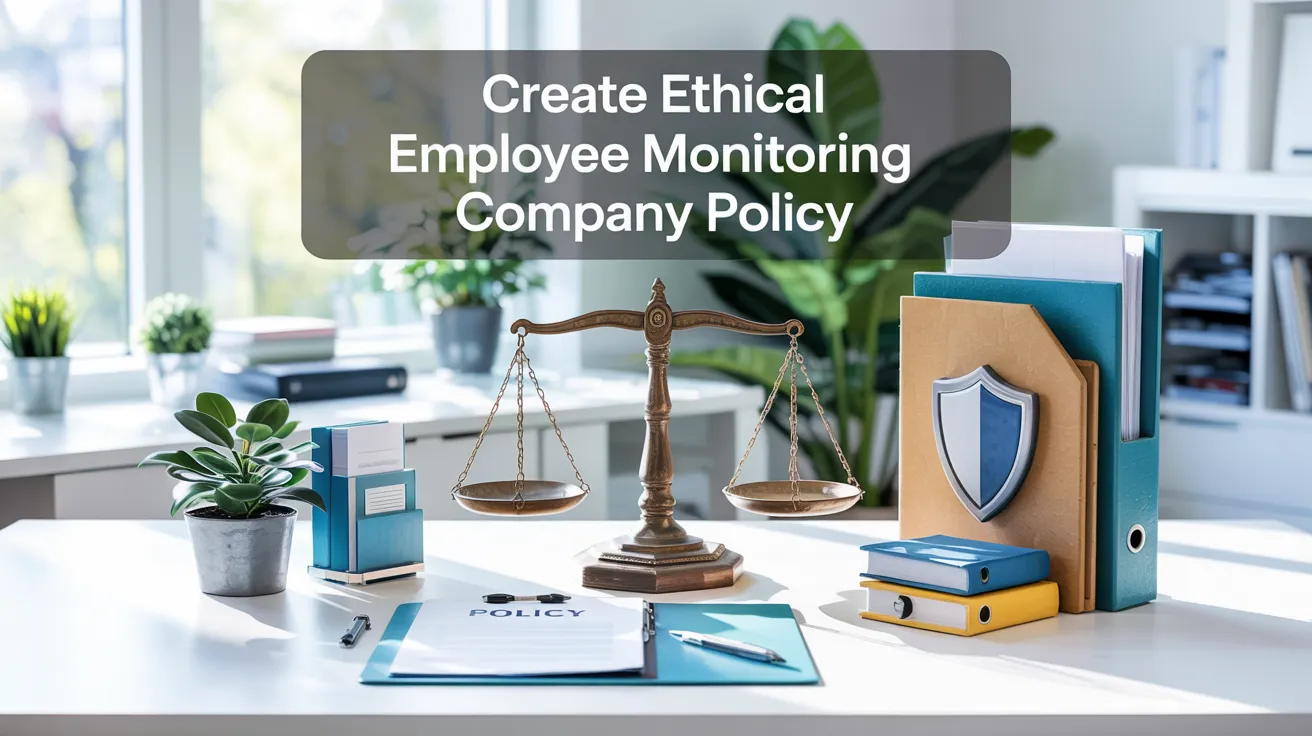
Summary:
-
1 in 6 employees in the U.S. quit because of increased surveillance.
-
Ethical monitoring is being open about workplace surveillance, explaining its purpose while respecting employee privacy.
-
Following privacy rules like GDPR and CCPA is a must when creating an ethical employee monitoring policy.
-
To make your monitoring policy ethical, define clear goals, get employee consent, ensure transparency, respect privacy, comply with laws, and review regularly to maintain trust.
By 2025, 70% of big companies will likely be monitoring their employees.
But is it ethical to always keep an eye on your workers?
Feeling watched at work can be a major downer. It can even be bad for your business!
So, is it possible to build a workplace where trust and transparency go hand-in-hand with productivity?
Absolutely! Let’s find out how you can create an ethical employee monitoring policy!
In this article:
- Components of an ethical employee monitoring policy
- Creating a fair employee monitoring policy
- Ethical employee monitoring company policy templates
- Monitoring employees in different work environments
- A quick look at global privacy laws
- What to do and what not to do when monitoring
Main Components of an Ethical Employee Monitoring Policy
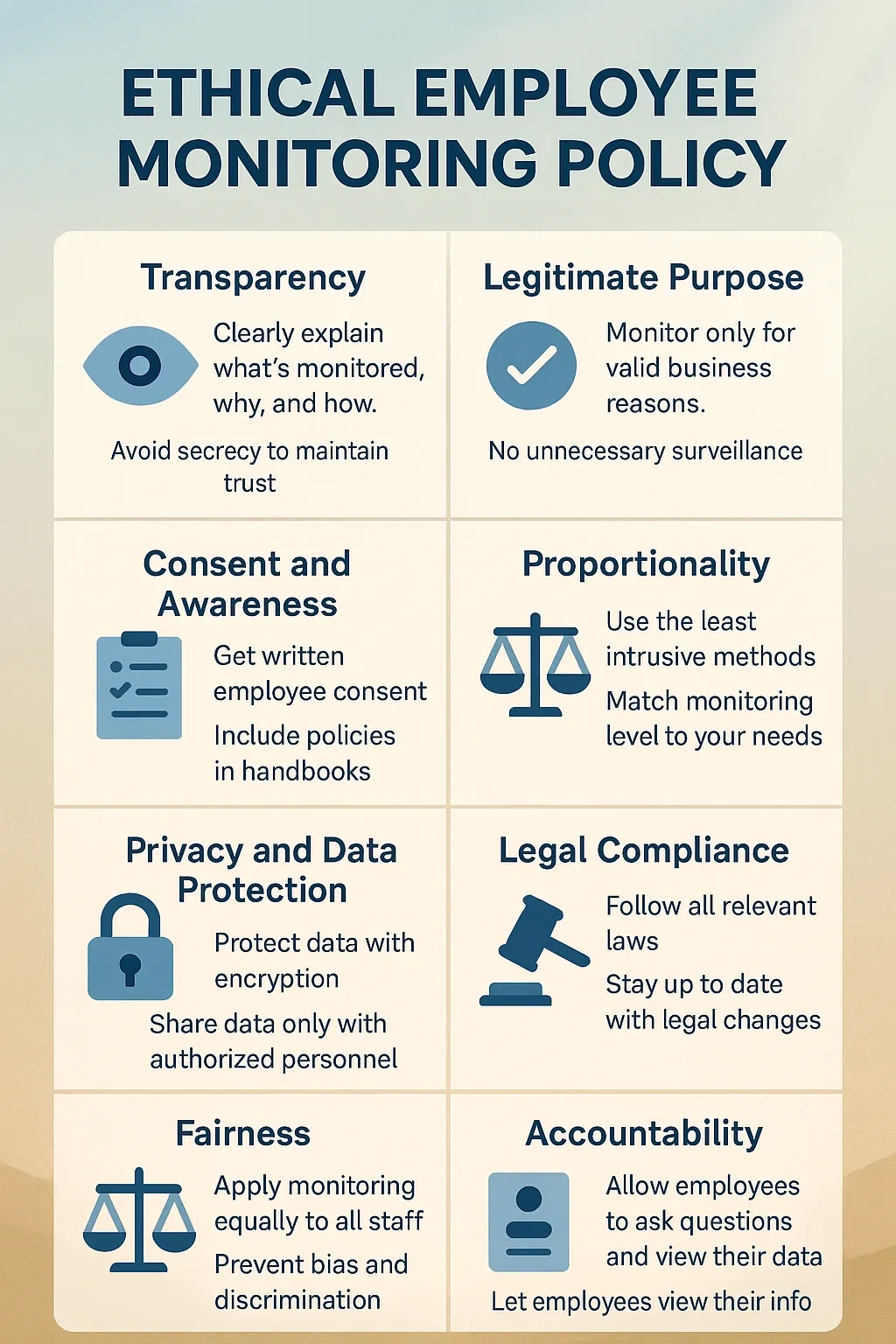
Creating an ethical employee monitoring policy isn’t just about installing software. You need to respect employee rights and promote a positive work environment.
Staying compliant with global privacy standards is also important!
Here’s what you need -
Transparency
Sadly, 41% of employees don't know what monitoring data is collected or why! This is not ethical.
Your team deserves to know exactly what employee activities you’re tracking.
Keeping secrets about monitoring can make people feel uneasy and create a toxic work environment.
Make sure your employees know the legitimate purposes, valid justification, business goals, and the types of employee monitoring!
Start monitoring with complete transparency
Legitimate Purpose
Watching what employees do should always have a real and important business reason. You might need monitoring to -
- Deal with insider threats.
- Protect company assets.
- Follow the legal requirements, legal obligations, and regulatory requirements.
- Help everyone increase employee productivity.
- Make things run more efficiently.
Just monitoring for the sake of it can feel like an invasion of privacy and isn't ethically right. Good monitoring is always tied to clear, legitimate business purposes!
Track with purpose, not just presence
Consent and Awareness
Showing respect for employee rights and employee privacy rights is key. Make sure to get your employee monitoring consent form before you start!
Not taking consent can have repercussions! Under the EU General Data Protection Regulation (GDPR), monitoring without consent or a strong legal basis can lead to fines.
Let your employees know all the monitoring policies in your employee handbooks, and get a written acknowledgement.
Monitoring personal computers or phones used for work?
Then, getting employee consent for monitoring is super important!
Proportionality & Minimal Intrusiveness
The amount of monitoring should directly match the risk or business need. Choose the least intrusive forms of monitoring to get the job done.
Too much monitoring can hurt job satisfaction and employee morale.
In the U.S., 1 in 6 employees quit because of increased surveillance! (Source: ExpressVPN
So, don't use invasive surveillance or invasive tools to collect personal details that aren't related to work!
Privacy and Data Protection
Protecting employee data is crucial for maintaining employee trust and morale. It also helps you avoid legal trouble. Use strong measures to protect the information you collect through employee monitoring efforts.
That includes:
- Encryption of monitoring data
- Role-based access control
- Data retention policies
Never forget to follow the privacy laws to protect employee data. Only let the right people see it, keep it safe, and don't hold onto it longer than you need to!
Legality and Compliance
Laws about employee privacy and online monitoring can vary a lot. Your policy must comply with regional laws such as:
- GDPR (EU)
- PIPEDA (Canada)
- CCPA (California)
- BIPA (Illinois, for biometric data)
Follow all the local, state, federal, and international legal frameworks and employee monitoring laws. Stay up-to-date on these rules to avoid legal repercussions and legal complications!
Stay compliant across global regulations
Fairness and Non-Discrimination
Treating people unfairly can create a negative atmosphere at work and even lead to legal problems. Apply your monitoring policies equally to everyone on your team.
Don't let bias or discrimination influence how you monitor!
This can lead to discriminatory practices.
Accountability and Employee Rights
Giving employees a voice shows you value their opinions. This will also help to build a more collaborative workplace!
Create clear ways for employees to ask about the monitoring policy. You can also let them see their own data if possible, and voice any concerns.
Respecting employee rights is key.
Make sure there's someone responsible for overseeing how monitoring is done!
How to Create an Ethical Employee Monitoring and Surveillance Policy (Guidelines)
Ready to build an ethical employee monitoring policy?
Simply follow these policy creation guidelines -
1. Define the Purpose and Scope
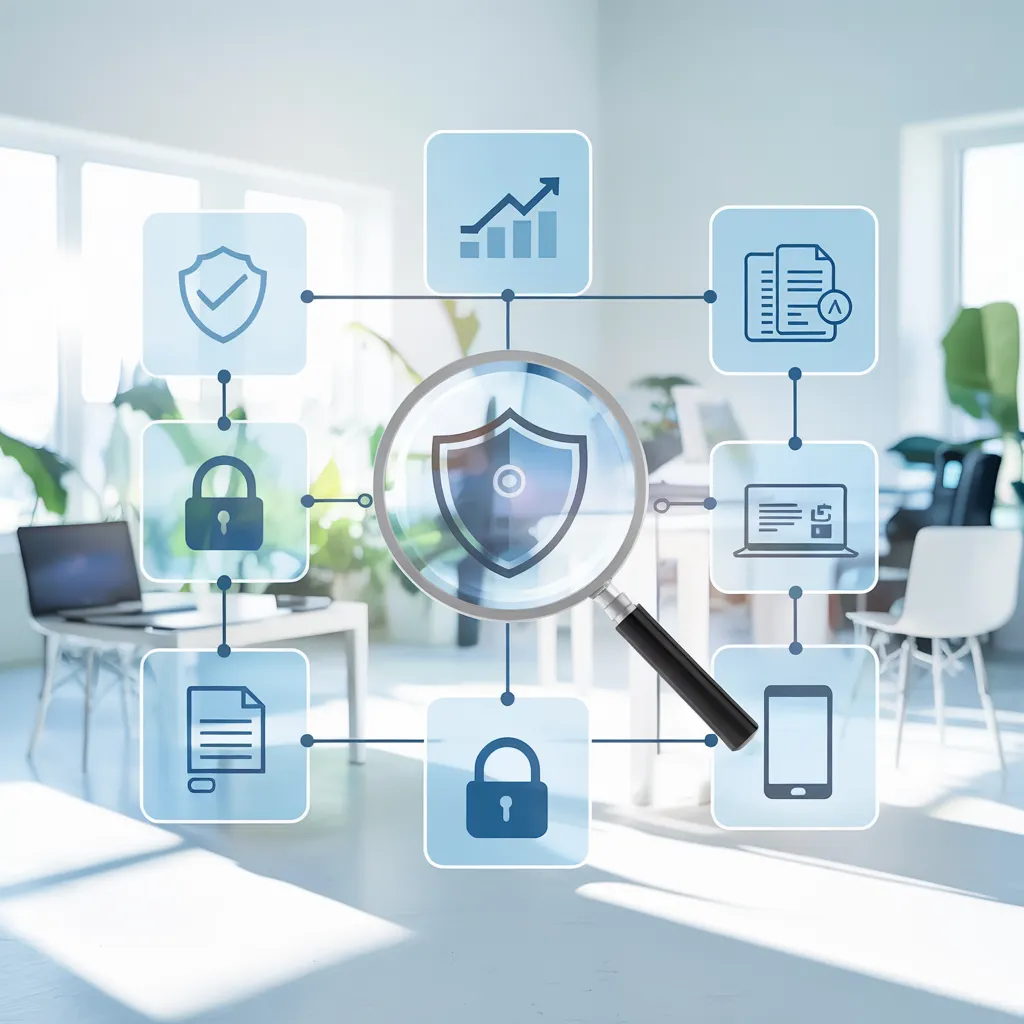
Get crystal clear on the legitimate purposes behind monitoring.
Is it to provide security against insider threats? Maybe it's to understand how your team uses tools to improve workflows and employee productivity?
Company transparency in the workplace about the "why" builds trust.
Does it apply to all employees, specific departments (like IT or HR), or just remote workers? Be clear about any exceptions!
At Google, the monitoring policy applies to all employees. But sensitive data access is limited to authorised staff only! This is for compliance with compliance with company policies and minimising risks.
Also, specify if it applies to all devices. Don’t forget company-owned devices and, if applicable, personal devices used for work!
2. Describe What Activities Will Be Monitored (Methods & Tools)
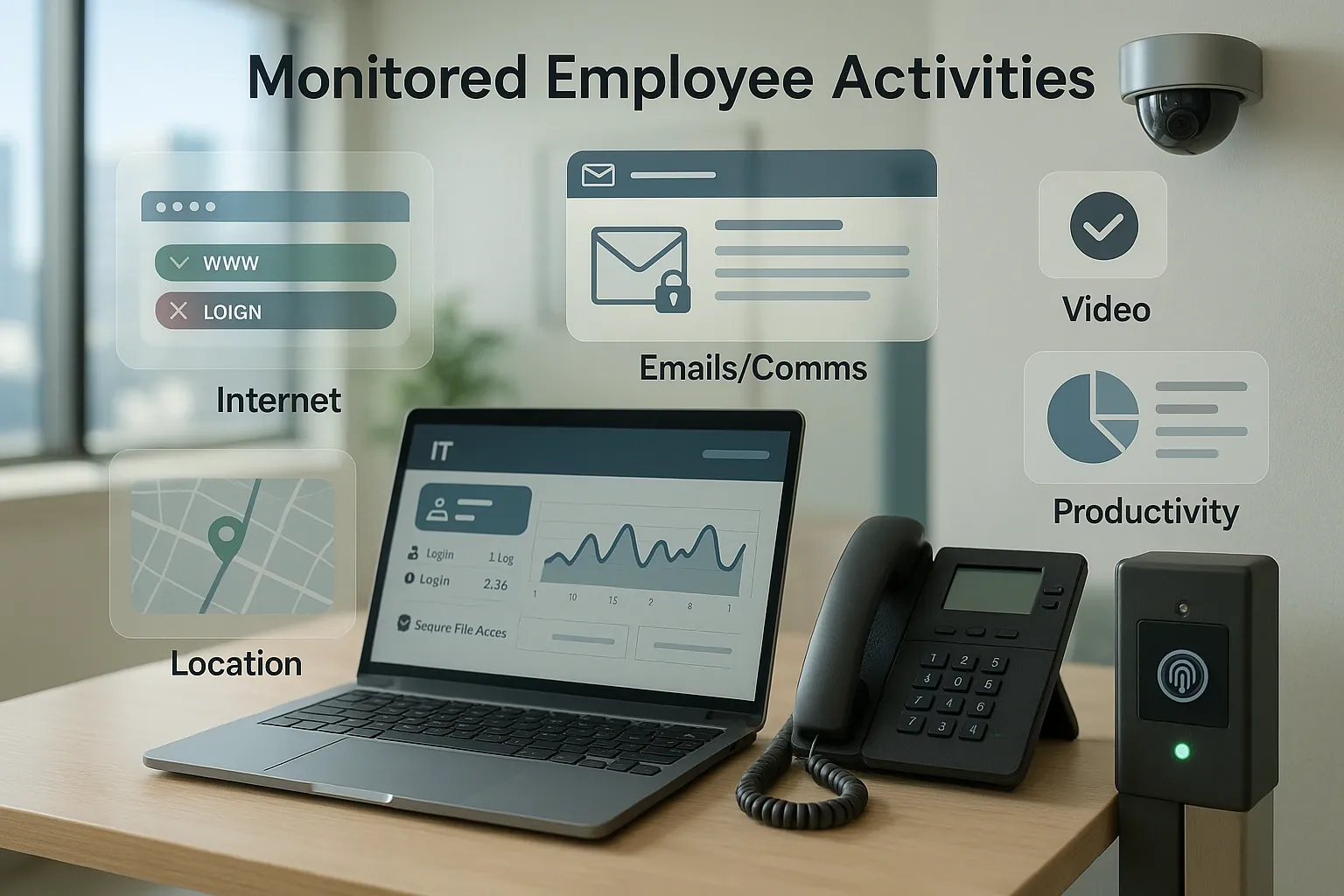
Clearly list every type of employee work activity that might be monitored. Remember the time-tracking software and employee monitoring methods you’ll use, too!
Computer and IT Usage
Will you track software use, file access, or login/logout times on company computers?
Monitor devices issued by the company, including file access and software usage. This will ensure productivity and prevent misuse!
Email and Communications
Will work emails be reviewed? If so, for what specific reasons (e.g., security, compliance)?
Monitor social media, employee emails, and chat messages for compliance, data leaks, or harassment.
Keep in mind that implementing email monitoring can help detect potential security breaches, though you should be careful to distinguish between work and personal email access.
Internet Access
What types of websites will be logged? Are there restrictions on internet usage?
Track web browsing history or set up web filters to block harmful or non-work-related content. You can use tools to monitor internet usage and online activities.
Telephone and VoIP Calls
Will calls be recorded? If yes, for what purpose (e.g., quality assurance, training)?
Record or monitor calls in environments like call centres to ensure quality standards are met.
Location (GPS) Tracking
If relevant for roles like delivery drivers, explain how location data is collected and used.
You can use geofence and GPS tracking for employees in fieldwork or driving company vehicles. Ensure that it’s not overly invasive. For example, tracking location outside of working hours!
Video Surveillance
Clearly state where cameras are located and their specific purpose. For instance, building security, safety in production areas. Must avoid monitoring private spaces.
Access and Badge Monitoring
Explain how entry and exit data are recorded and used (e.g., security, attendance). You can use ID badges or biometrics to track entry and exit points for security and safety.
But don’t use it as a method of tracking personal movement!
Biometric Data
Biometric data is highly sensitive and regulated in some regions. If you use fingerprints or facial recognition, explain what data is collected, how it's secured, and its specific purpose (e.g., secure access).
Productivity and Screen Monitoring Software
Ethical employee monitoring tools, like Apploye, track active time (mouse/keyboard use) vs. idle time (no activity). It calculates an activity level based on this input. You can also monitor productivity levels on specific tasks, along with application usage and online activity.
Additionally, Apploye is a 100% accurate time tracker with screenshots. It monitors employee screens by taking snapshots at random intervals. It can even record the screen now!
Track productivity ethically and seamlessly
3. Explain the Usage and Protection of Collected Data
Explain how you will collect, monitor, and store the data. You should prioritise data privacy compliance and security, and follow local laws.
- Usage of Data: Only use the data for the stated purpose in the policy. This can be for improving productivity, ensuring security, or meeting compliance requirements. The policy should explicitly prohibit using the data for unauthorised purposes.
- Data Storage: Clarify how long the data will be kept. Retention periods should not be excessive. For example, you can keep logs for 90 days and delete them afterwards. This is unless it's required for legal reasons!
- Data Access: Limit access to monitoring data to authorised personnel. This minimises the risk of unauthorised data exposure.
- Security Measures: Describe the methods used to protect data. They can be encryption, secure servers, and strong authentication protocols!
4. Clarify Who the Policy Applies To (and Any Exceptions)
You should also specify who is covered by the monitoring policy and whether any employees or groups are excluded.
- Who It Applies To: Clearly define if the policy applies to all employees, specific teams, contractors, or just full-time workers. For example, there are different employee monitoring programs for on-site and remote workers.
- Exceptions: You may exclude some employees from certain monitoring practices for their role. Legal, medical, or HR departments need confidentiality or specific privacy measures.
Customize monitoring for different teams
5. Include Legal Compliance Statements
Your monitoring policy must follow local and international regulations to avoid legal repercussions!
Explicitly state that your policy is designed to comply with all relevant legal requirements -
Compliance with Laws
Mention specific privacy laws like GDPR, CCPA, or local regulations relevant to your operations. Ensure that your policy complies with these laws. This is more important for the collection and storage of personal data!
Microsoft has a well-defined privacy policy that follows international data protection laws.
You can use compliance management software, too!
Ensure operational compliance with Apploye
Consent and Acknowledgement
Explain the process for getting employee consent, where necessary. Also, include how employees will formally acknowledge the policy.
Otherwise, monitoring devices without consent can create serious legal and ethical issues.
No Expectation of Privacy on Company Systems
Respecting employee privacy is important. But using company equipment and networks generally means less privacy. Everyone should have the right expectations!
Make it clear that you are doing the monitoring by the law and the company's objectives.
6. Consequences and Enforcement

Amazon was fined €32m (£27m) in France for "excessive" surveillance of its workers!
So, it’s important to clear penalties for violating the policy. This helps maintain order and deters misuse.
Employee Violations
These could include misusing company resources, using mouse jigglers to bypass monitoring systems, or sharing confidential data inappropriately. Violations may lead to disciplinary action, from warnings to termination!
Company & Manager Violations
What if the management or the company itself abuses monitoring privileges?
If they try accessing personal data without consent or misusing monitoring tools, penalties must be clear. This could include legal action or internal HR procedures.
7. Policy Review and Updates
Monitoring technologies evolve, and so do laws and regulations. So, you should also review and update your policies -
- Review Frequency: Set a schedule for regular policy reviews, typically on an annual basis or when new employee monitoring technologies are introduced.
- Feedback Mechanisms: Implement a system that gathers employee feedback about the policy. This promotes a sense of inclusion and transparency.
- Revision Tracking: Keep track of any changes to the policy over time. Share the revised policy with all employees or communicate any changes!
Try to maintain ethical HR policies and the workplace privacy laws!
8. FAQ Section (Optional)
Try to address common employee questions, such as:
Q: Can I use my work laptop for personal browsing off-hours?
A: Keep personal use minimal and within our acceptable use policy. While off-hours activity might be logged by our monitoring software, we usually only review it if there's a security issue.
Q: Will my webcam or microphone be used to monitor me?
A: No, we won't activate your webcam or mic for general employee monitoring. The exception is during scheduled video meetings, where their use is necessary for communication.
Q: Can my manager see my private messages on company communication platforms?
A: Our monitoring practices focus on work-related communication on company channels. Private messages are generally not reviewed without a specific, legitimate reason and proper authorisation.
Q: What happens to the data collected through monitoring? Is it used to evaluate my performance?
A: Collected data serves legitimate purposes like security and understanding employee behavior trends. While it could inform employee performance, it's usually combined with other factors, and individual evaluations are holistic.
Q: I sometimes use my personal phone for work-related quick messages. Will that be monitored?
A: Our monitoring policy mainly applies to company-owned devices and networks, not your personal devices. However, remember to still follow company policies when doing company business on any device.
Sample Employee Monitoring Policy Templates
Small Business Policy Template (e.g., under 50 employees)
Purpose: To ensure security and appropriate use of company systems while respecting employee privacy.
Scope: Applies to all employees using company equipment or networks.
What We Monitor:
- Website and email activity on company devices.
- Office entry via keycards.
- Security camera footage in public areas.
What We Don’t Monitor:
- Personal devices or off-hours activity.
- Private areas (e.g., restrooms).
Data Use: Monitoring data is used only for security, compliance, or performance issues. Access is limited to management and IT.
Employee Notice: Employees are notified of monitoring during onboarding and via posted notices.
Consent: By using company systems, employees consent to this monitoring. Acknowledgment is signed at hire.
Contact: Direct questions to the office manager or HR lead.
Mid-Sized Business Policy Template (e.g., 100–500 employees)
Overview: To protect our systems, data, and team productivity, Company X monitors digital and physical work environments in line with privacy regulations.
Covered Activities:
- Computer usage (apps, websites).
- Emails and chat systems.
- Physical access logs and office CCTV.
- Use of GPS in company vehicles.
- VoIP/call center recordings (where applicable).
Data Handling:
- Data is securely stored and retained for specific business needs.
- Access is role-based (HR, security, compliance).
- Monitoring is not used for minor infractions or personal behavior.
Transparency & Fairness:
- All employees are informed and must acknowledge the policy.
- Monitoring tools and purposes are disclosed and limited to business-related concerns.
Employee Rights: Employees can request their monitoring data. We support privacy rights under applicable laws.
Policy Review: Reviewed annually and updated as needed.
Large Company Policy Template (e.g., 1000+ employees / global)
Purpose: To support operational integrity, legal compliance, and a safe, productive environment through proportionate and transparent monitoring.
Applies To: All employees, contractors, and third parties using Company Y systems or premises.
Monitoring Includes:
- IT systems: web, apps, emails, productivity tools.
- Security: building access, video surveillance.
- Field operations: GPS, device tracking.
- Compliance: recording of regulated communications.
Safeguards:
- Clear lawful basis (e.g., legitimate interest or legal obligation).
- Data minimization: only what's necessary, for as long as needed.
- Regional compliance (e.g., GDPR, CPRA, BIPA).
- DPIAs are conducted for high-risk tools.
Employee Communication:
- Policy shared at onboarding and via the intranet.
- Employees notified of updates.
Contacts for questions: Data Protection Officer (EU/UK), HR Compliance (US/Canada).
Oversight: Misuse of monitoring data is grounds for discipline. Human oversight is required for decisions based on monitoring.
Creating Employee Monitoring Policy for Different Work Environments
Every work setup comes with unique monitoring needs. A one-size-fits-all approach doesn’t work when it comes to ethical employee surveillance.
So, your employee monitoring policy needs to be flexible!
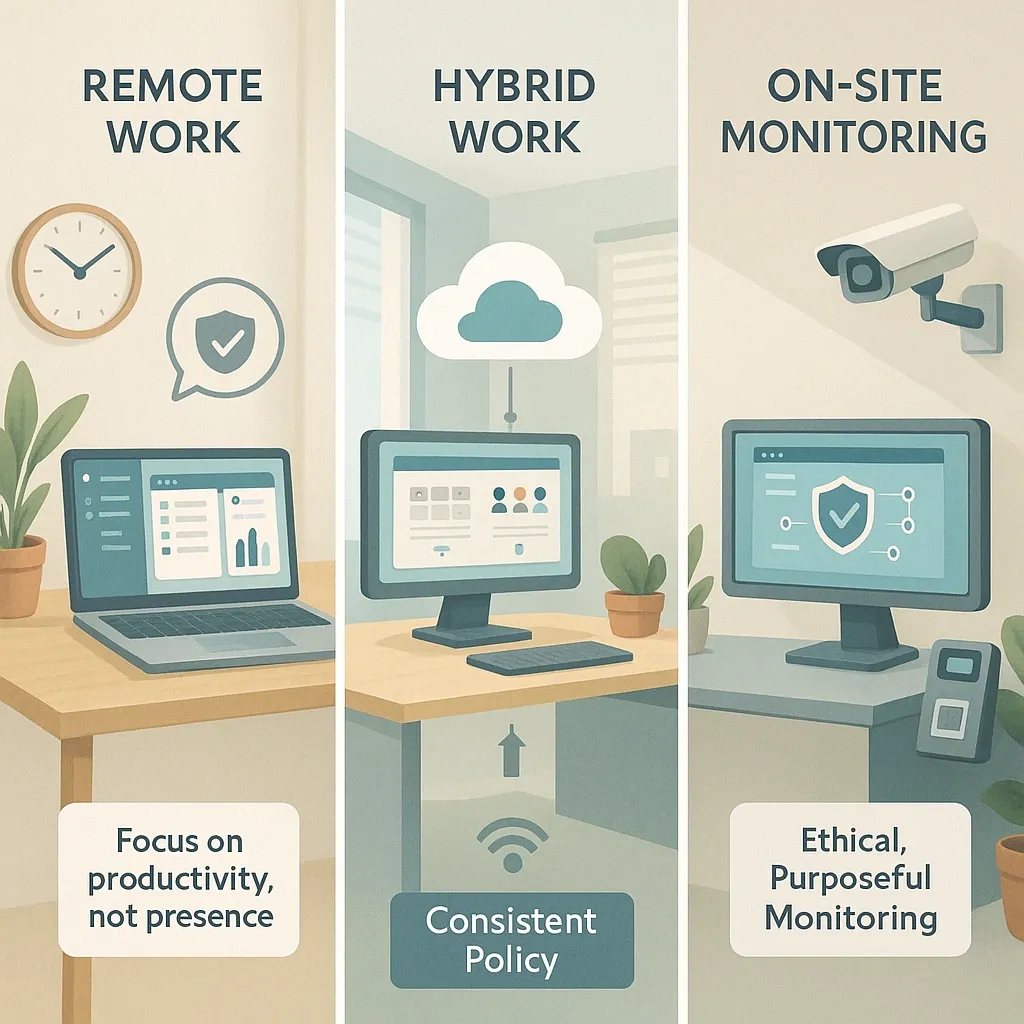
Alt text: Divided image showing remote, hybrid, and on-site workspaces with ethical monitoring tools.
Remote Work Monitoring
65% of workers said they’d be more productive at home doing remote work than in a traditional office environment.
Remote work has risen particularly after COVID-19. And the remote employee monitoring tool must respect employee privacy.
Ensure productivity and data security during remote onboarding, too!
Respecting Home Privacy
Remember, their home is their personal space. Monitoring on personal devices should be minimal. You should also have explicit consent for specific, work-related reasons.
Follow the work-from-home policies too! For example, avoid invasive tools that track personal browsing history.
Productivity vs. Presence
Focus on what gets done, not just how long they're online. Use employee productivity software that tracks task completion or project progress, rather than constant screen monitoring.
Working Hours and Off-Hours
Clearly define employee work hours and generally avoid monitoring outside those times. Respect their personal time and boundaries.
Use of Personal Equipment
Be very transparent about whether you’ll monitor personal devices used for work (e.g., for security reasons). Clearly outline what's tracked and why.
Communication Expectations
Set clear expectations for availability on Slack, Zoom, or Teams. Let employees know if and when those communications are reviewed.
Hybrid Work Monitoring
In a hybrid environment, employees switch between home and office. So, it’s important to create consistent policies that travel with the employee.
Consistent Policies
Aim for consistent monitoring policies! Maintain it, whether an employee is working from home or in the office, to ensure fairness.
Device Switching
Clearly explain how monitoring applies when employees switch between company-owned devices in the office and potentially personal devices at home.
Office vs. Remote Days
Remind teams that monitoring tools may behave differently depending on the network or location. Use cloud-based tools that work in both settings, like Apploye or Teramind.
Team Dynamics
Avoid excessive individual monitoring that can damage trust. Instead, use team dashboards to encourage transparency. This approach helps establish boundaries between employees while maintaining productivity.
Equipment and Network
Offer secure VPNS and enforce endpoint protection for remote connections to protect company data and avoid legal issues.
Unify office & home monitoring seamlessly
On-Site (In-Office or On-Premises) Monitoring
Monitoring in the workplace office settings focuses more on security, infrastructure usage, and compliance.
Try to use as much privacy-focused monitoring software as you can.
Video Surveillance
Use strategically for security and safety in common areas, clearly indicating their presence. Avoid placing cameras in private workspaces.
Physical Entry/Exit Monitoring
Use access card logs or biometric entry systems ethically, and only for safety or attendance tracking.
Network and Computer Monitoring on-site
Explain employee computer monitoring and internet activity on the company network for security and compliance.
Workspace Privacy
Respect reasonable expectations of privacy in personal workspaces within the office. Avoid unnecessary monitoring of individual workstations.
Manufacturing or Fleet Environments
Be transparent about why employee location or company vehicles are being monitored. Be mindful of not monitoring personal items within these contexts.
For instance, logistics companies often use GPS tracking in company vehicles for efficiency and employee safety, with clear policies communicated to drivers.
Personal items
Be cautious about inspecting personal bags or belongings. Clear policies should state when and why checks happen to prevent discrimination.
Implement ethical on-site monitoring now
Legal and Ethical Implications Across Regions for Employee Monitoring Policies
Thinking about employee monitoring practices across different countries? It's like navigating a maze of rules! What's okay in one place might get you in trouble in another.
Let’s take a look at some major regions -
United States Employee Monitoring Policy
Generally, employers here have a bit more leeway. However, employees still have some expectations of privacy at work.
There are federal regulations (Electronic Communications Privacy Act or ECPA) about online watching. But each state (like New York and California) can have its own extra privacy laws.
Dealing with things like fingerprints (biometric data)? There are even more specific rules! For example, the Biometric Information Privacy Act in Illinois.
Plus, there are laws about how employees can talk about work stuff (NLRA). These can affect monitoring, too!
European Union Employee Monitoring Policy
The GDPR is a big deal here! It has really strong rules about using people's data, including when you're monitoring activity. You need a good reason to watch, and transparency in employee monitoring.
Is your monitoring high-risk? You might even need to do a special check (Data Protection Impact Assessments)!
United Kingdom Employee Monitoring Policy
They have the UK GDPR, which is very similar to the EU's rules. The Information Commissioner's Office also gives specific advice on workplace monitoring policy. Consider the Regulation of Investigatory Powers Act 2000 and general human rights!
Canada Employee Monitoring Policy
There's a main federal law (Personal Information Protection and Electronic Documents Act or PIPEDA). But some provinces like Alberta and Québec have their own privacy laws that are pretty similar. Ontario now even has a law saying you have to tell employees if you're watching them electronically and why. Court decisions also play a role in understanding workplace privacy.
Why Most Monitoring Policies Fail And What Ethical Ones Get Right
When companies decide to monitor their employees, they face a crucial choice: will it be about control or collaboration?
This is important for your corporate governance or corporate social responsibility (CSR) too!
Control vs. Collaboration in Monitoring
Many use intrusive technologies for control-focused monitoring: tracking typing, emails, webcams, and even biometric data. This signals distrust, hurts employee morale, disengages them, and increases turnover. Feeling constantly watched creates stress and leads to a decline in loyalty.
Ethical principles in monitoring choose collaboration, built on transparency, respect, and partnership. It involves open talks about what's tracked and why. This type also uses data to support employee growth, productivity, and employee well-being, not just to punish!
Employee monitoring solutions like time tracking software can highlight workload issues.
Platforms like Apploye promote transparent employee monitoring by letting employees see tracked data and context, fostering trust!
Monitor your employees the right way
Real-World Comparison: IKEA vs. Microsoft
Stealth Employee Monitoring in IKEA
Monitoring Style: Secretive, control-driven
IKEA was fined €1 million after it was revealed that management spied on staff and job applicants, including accessing police records without consent. Employee morale suffered, and the scandal damaged IKEA's employer brand.
Consequences: High employee distrust, legal consequences, and negative publicity.
Ethical Employee Monitoring in Microsoft
Monitoring Style: Transparent, collaborative
Microsoft shifted to focusing on performance for hybrid work, not just presence. They emphasised regular chats between managers and employees about their work. Their own surveys show this led to more trust and happier employees, and fewer people leaving compared to other tech companies.
This approach strengthened their company culture and demonstrated the benefits of employee monitoring when done right.
Consequences: High employee engagement, lower turnover, positive sentiment.
Final Thought: Ethical Monitoring isn't Just a Policy — It's a Competitive Advantage
Ethical monitoring isn't just about ticking boxes on a policy. It's actually a way to make your company a better place to work, giving you a real advantage!
Tell your team why you're doing it and what you're looking at. Focus on real needs, like keeping things secure or helping everyone work better. Treat everyone the same, keep their info safe, and follow the rules. When you're honest and respectful, you build a culture of trust.
Plus, following the rules and being fair helps you avoid legal issues and keeps your company's reputation strong. That's the key to a happy and successful team!
Effective employee monitoring policies balance security needs with respect for individuals.
Start building trust with ethical monitoring
Frequently Asked Questions about Ethical Employee Monitoring Company Policy
What are the ethical considerations in monitoring?
Basically, it means being upfront with your team about what you're watching and why. It's about having a real business reason, being fair to everyone, keeping their data safe, and following the law. Think of it as monitoring with respect for people's privacy. Understanding ethical concerns should be a priority before implementing any monitoring system.
Is it ethical for an employer to monitor their employees?
It can be, if they're clear about it and have a good reason, like security or making sure things run smoothly. But sneaking around or watching too much? That's generally not ethical. The level of monitoring should always be proportionate to the legitimate business need.
Are employee monitoring systems illegal and unethical?
Not necessarily, but the way they're used matters. If you don't tell people what's being tracked or why, or if it feels like constant spying for no good reason, it can be unethical and maybe even against the law.
What are the ethical boundaries of tracking employee activities?
Stick to what's actually work-related during work hours. Don't snoop on personal stuff. And try to use the least "in your face" ways to monitor. Monitoring should focus on relevant aspects of employee activity directly related to work.
How can employee monitoring ethics balance productivity and privacy?
Focus on the bigger picture – what people are achieving, rather than every little click. Use less intrusive tools and make sure everyone knows what the expectations are.
How can you monitor ethical standards in an organisation?
Check your policies regularly to make sure they're fair and still needed. Ask your team for their thoughts, and make sure managers know how to monitor ethically. Have a way for people to voice concerns. Creating channels for employees to provide feedback helps maintain ethical standards.
How can I monitor my employees without letting them know about it?
Generally, that's not ethical and can get you into legal trouble. Being open and honest is usually the better way to go. It's advisable to consult with a legal expert before implementing any form of monitoring.
How do we monitor employees while respecting data privacy?
Use strong security to protect the info, limit who can see it, and don't keep it longer than you have to. Let your team know how you're keeping their data safe.
What are the ethical considerations companies should address when monitoring remote employees' productivity and online activity?
Remember, their home is their private space. Focus on what they're getting done, not just when they're online. Be clear about work hours and be careful about monitoring their personal devices. Remote monitoring should enhance employee accountability without being intrusive.
Is it ethical to monitor employees in the workplace?
Yes, if it's for good business reasons (like safety or security), you're open about it, and you're not being overly intrusive. Implementing real-time monitoring should only be done when necessary for security or legitimate operational purposes.
How can an employee's productivity be legally monitored and measured?
Use project management tools, performance metrics, and time-tracking software. Always make sure to inform the employees to get their consent when needed. Involve employee representatives in developing monitoring policies.
Is it legal/ethical/moral if your employer demands you install a monitoring/tracking app on personal computers that employees use to work from home?
This enters a grey area. It’s legal in some places with consent, but ethically, it should be minimised. Employers should offer work devices instead of tracking personal ones. Every form of employee monitoring should be carefully evaluated for necessity.
Is it ethical for companies to monitor employees who are WFH using tracking applications to view computer screens, open windows, and monitor mouse movements?
It depends on the intent and transparency. Over-monitoring feels intrusive and may harm trust, especially if performance isn't an issue. Any monitoring that might detect suspicious activity should be balanced with respect for privacy.
Can a company monitor its employees' computer activity, even if they use passwords?
Yes, companies can monitor work-related activity on their systems. Passwords don’t override company access rights, but monitoring must still be ethical. The concerns around employee monitoring should be openly addressed with staff.
Is it considered ethical for a company to monitor an employee's personal phone usage during work hours?
Generally, no. If it’s a personal device, monitoring is invasive. Employers should focus on work performance, not personal phone habits.
Is it ethical for HR to look into an employee's data out of curiosity?
Absolutely not. Never access employee data without cause or consent! It's unethical and requires disciplinary action.

